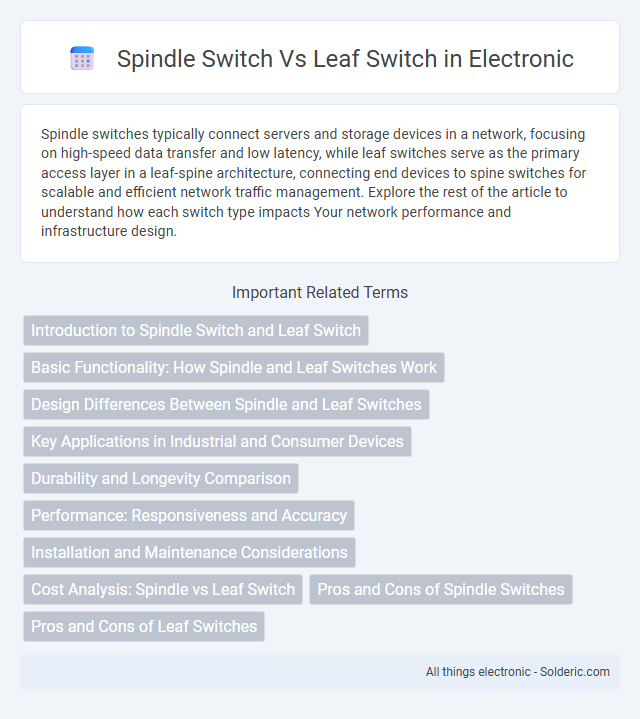Spindle switches typically connect servers and storage devices in a network, focusing on high-speed data transfer and low latency, while leaf switches serve as the primary access layer in a leaf-spine architecture, connecting end devices to spine switches for scalable and efficient network traffic management. Explore the rest of the article to understand how each switch type impacts Your network performance and infrastructure design.
Comparison Table
| Feature | Spindle Switch | Leaf Switch |
|---|---|---|
| Role in Network | Connects multiple devices in a central location | Connects to spine switches, aggregating access devices |
| Position | Access or aggregation layer | Access layer |
| Scalability | Limited scalability in large networks | Highly scalable, supports large data centers |
| Latency | Higher latency due to centralized design | Lower latency, optimized for east-west traffic |
| Traffic Flow | Southbound to core network | East-west traffic between servers and spine |
| Common Use | Small to medium enterprise networks | Data center and cloud environments |
| Fault Tolerance | Single point of failure risk | High redundancy with multiple paths |
Introduction to Spindle Switch and Leaf Switch
Spindle switches and leaf switches serve crucial roles in network architecture, with spindle switches typically handling core network traffic through high-capacity data aggregation and leaf switches operating at the edge to connect end devices. Spindle switches prioritize high throughput and scalability to support large data flows, while leaf switches focus on low latency and efficient access layer connectivity. Your network design benefits from understanding these differences, ensuring optimized performance and resource allocation across layers.
Basic Functionality: How Spindle and Leaf Switches Work
Spindle switches aggregate multiple access switches to form a centralized distribution point for data traffic, enabling efficient routing and policy enforcement in traditional network architectures. Leaf switches operate as top-of-rack devices in modern leaf-spine networks, directly connecting servers and endpoints while forwarding data to spine switches for high-speed interconnection and minimal latency. Leaf switches prioritize scalability and low-latency communication by distributing traffic evenly across spine switches, whereas spindle switches centralize traffic flow, often limiting scalability and increasing bottlenecks in large-scale environments.
Design Differences Between Spindle and Leaf Switches
Spindle switches feature a centralized architecture where all connections converge through a single switch, optimizing for simplicity in smaller networks, while leaf switches are part of a two-tier topology connecting directly to spine switches, enhancing scalability and reducing latency. Leaf switches handle east-west traffic between servers efficiently, whereas spindle switches often manage north-south traffic to external networks. Your network's design choice depends on scalability requirements and traffic patterns, with leaf switches better suited for large data centers demanding high performance and redundancy.
Key Applications in Industrial and Consumer Devices
Spindle switches are predominantly used in industrial applications requiring precise motor control and high torque, such as CNC machines and robotics, while leaf switches are common in consumer electronics for their compact size and quick response, ideal for smartphones and laptops. Your choice of switch impacts device performance, with spindle switches offering durability in heavy-duty environments and leaf switches providing rapid actuation in everyday gadgets. Understanding these distinctions helps optimize switch selection for specific industrial or consumer device needs.
Durability and Longevity Comparison
Spindle switches typically offer higher durability due to their robust mechanical design, making them ideal for environments requiring long-term reliability under heavy usage. Leaf switches, while more advanced in network scalability and flexibility, may have shorter lifespans because of their complex electronic components. Your choice should consider the operational demands and durability requirements to ensure optimal longevity.
Performance: Responsiveness and Accuracy
Spindle switches often exhibit higher performance in environments demanding rapid responsiveness due to their centralized control architecture, which optimizes data flow and reduces latency. Leaf switches, designed to handle distributed workloads, provide enhanced accuracy in traffic management by enabling direct device connections and minimizing bottlenecks. Your network's specific requirements for speed and precision will determine the optimal choice between spindle and leaf switch configurations.
Installation and Maintenance Considerations
Spindle switches typically feature a modular design that simplifies installation and allows for easy expansion, reducing downtime during network scaling. Leaf switches often require more careful planning due to their fixed-port configurations, but their straightforward setup supports efficient initial deployment and streamlined maintenance. Regular firmware updates and physical inspections are crucial for both switch types to ensure optimal performance and minimize network disruptions.
Cost Analysis: Spindle vs Leaf Switch
Spindle switches typically incur higher upfront costs due to their centralized architecture and increased port density requirements, impacting initial investment and scalability expenses. Leaf switches offer more cost-effective scalability with modular deployment, reducing overall capital expenditures in large-scale data centers. Operational costs favor leaf switches as they support distributed traffic management, leading to improved energy efficiency and easier maintenance compared to spindle switch configurations.
Pros and Cons of Spindle Switches
Spindle switches offer high port density and improved scalability, making them suitable for large data center networks requiring efficient traffic management. However, their complexity can lead to higher costs and increased power consumption compared to simpler leaf switches. Maintenance and troubleshooting may also be more challenging due to the intricate architecture of spindle switches.
Pros and Cons of Leaf Switches
Leaf switches offer high port density and simplified network management, making them ideal for large-scale data center environments. Their low latency and efficient east-west traffic handling improve overall network performance. However, they can become bottlenecks if not paired properly with spine switches, and scaling beyond a certain point may increase complexity and cost.
spindle switch vs leaf switch Infographic

 solderic.com
solderic.com